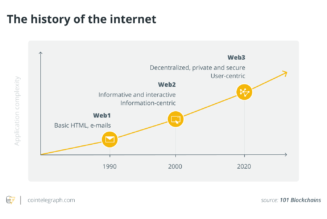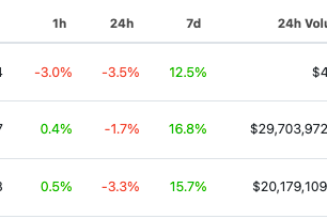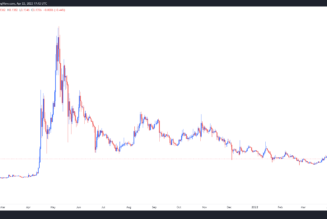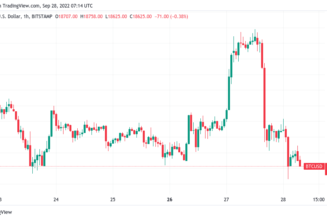
In the past year, we’ve seen the crypto economy undergo exponential expansion as heaps of money poured into various cryptocurrencies, decentralized finance (DeFi), nonfungible tokens (NFT), crypto indices, insurance products and decentralized options markets.
The total value locked (TVL) in the DeFi sector across all chains has grown from $18 billion at the beginning of 2021 to $240 billion in January 2022. With so much liquidity in the ecosystem, the crypto lending space has also grown a significant amount, from $60 million at the beginning of 2021 to over $400 million by January 2022.
Despite the exponential growth and the innovation in DeFi products, the crypto lending market is still only limited to token-collateralized loans, i.e. pledge one cryptocurrency as collateral to borrow another cryptocurrency.
There are a few platforms such as Nexo and Genesis that provide NFT-collateralized loans but the service is mainly for institutional clients with blue-chip NFTs. For the retail masses, there isn’t much more than just the token-collateralized loans.
If the crypto economy wants to grow to a size that is compatible with any real economy, it will have to reach out to the mass of retail consumers and be able to provide financing options to them.
Here are the essential components that need to develop before crypto banking infrastructure can rival that of banks.
Diversity of goods and services
One of the most commonly asked questions from someone who is new and wants to enter the crypto economy is — what can I buy? In the current infrastructure, there is not much other than NFTs, DeFi products, staking and liquidity provision.
In a traditional economy, currencies exist because exchanging goods for services, or vice versa, generally does not have a 1:1 ratio, so currencies serve the purpose of facilitating transactions of goods and services. In the crypto economy, currencies exist before goods and services become widely available to customers. This makes crypto currencies hard to evaluate and unstable.
An economy needs to have sufficient goods and services available to create enough supply and demand so consumers can use currencies to exchange for these goods and services. With only NFTs and DeFi financial products in the current crypto ecosystem, it is very hard to attract the ordinary Joe or Jane into the economy because there is simply not much for them to consume.
A healthy and functional banking system also relies on sufficient supply of liquidity from customer deposits and sufficient demand from customers to borrow. With more digital goods and services, especially non-financial ones such as art, music, real estate or gaming gear in the metaverse, the banking system will be able to utilize them as collateral to provide a diversity of secured loans. Similar to car loans or mortgages, consumers in the crypto world will be able to own these products by paying periodically in the future.
A reliable credit scoring system
In the current crypto lending market, no credit check or credit scoring system is needed for customers to borrow any crypto currency. This is because the loan is over-collateralised with a strictly monitored loan-to-value (LTV) ratio. As soon as the LTV goes above the liquidation LTV threshold, the collateral will be sold at a discount to recover the loan. The collateral value is never fully utilised and there is always a large buffer reserved in case of sudden collateral value depreciation.
In traditional banking, customers have a credit score based on their past transactional behaviour and financial condition i.e. annual income, savings, loan repayments and investments. In the crypto lending market this is almost impossible because the wallets are created anonymously and anyone can create as many wallets as they want. This makes it very difficult to track transactional behaviours and difficult to build a credit score.
For the current structure to change, users need to be incentivised for building a good track record of all the activities within a wallet and being loyal to the wallet. There are scores such as LUNAtic Rankings for Terra to rank order engagements within a certain chain, but there doesn’t seem to be any credit-specific scoring to rank order wallet owners’ financial condition.
As more jobs are created in the crypto space and more people are paid in cryptocurrency, wallets that show a long healthy track record of activities such as a constant income of cash inflow, continuous stable balance or regular repayments to a crypto loan, should be rewarded. The reward could be in the form of gaining access to larger loans with lower interest rates; or gaining access to longer-term loans; or even in the form of airdrops of governance tokens.
A strong credit scoring system would benefit both the lender and the borrower. The lenders can earn more fees with lower risk by providing more loans to trust-worthy borrowers; the borrowers can have access to lower rates, longer-term loans and other potential rewards. Most importantly, a credit scoring system could help form a more transparent and healthy crypto lending market and attract more consumers to the ecosystem.
An actively managed collateral evaluation system
Given the highly volatile nature of cryptocurrencies (at least for now), the collateral value needs to be assessed much more frequently than in a traditional secured loan. Unlike traditional collateral such as cars or houses whose values are more predictable and do not change dramatically during a short period of time, the collateral in the crypto world, such as NFTs or crypto currencies, could encounter sudden downside movements in just one day. Therefore, it is essential for lending platforms to have robust collateral evaluation systems that can estimate the market value of any asset at any time.
It is not difficult to evaluate the market value of NFTs or cryptocurrencies minute-by-minute. But as more goods and services become available in the crypto ecosystem and more types of assets become eligible as collateral, having a high-frequency collateral evaluation system can be costly.
Alternatively, lending platforms can create something similar to the concept of risk-weighted assets (RWA) in the banking world to give more risk weights (lower liquidation LTV thresholds) to riskier collateral and less to safer ones so they don’t necessarily need to have a high-frequency collateral evaluation system.
For example, blue-chip NFTs such as the Bored Ape Yacht Club (BAYC) can be given a higher liquidation LTV threshold and evaluated less frequently. As more historical NFT prices become available, more data points can be collected and used to derive a more accurate risk weight metric.
As more goods and services become available in the crypto economy, a reliable credit scoring system and an actively managed collateral evaluation system will enable crypto banking infrastructure to provide more financing options other than token-collateralized loans.
The future outlook of crypto finance is dependent on the types of goods and services available to the crypto economy and it can only rival the scale of traditional banks when the crypto economy grows into a more diversified and appealing market space to more consumers.
The views and opinions expressed here are solely those of the author and do not necessarily reflect the views of Cointelegraph.com. Every investment and trading move involves risk, you should conduct your own research when making a decision.
 [flexi-common-toolbar] [flexi-form class=”flexi_form_style” title=”Submit to Flexi” name=”my_form” ajax=”true”][flexi-form-tag type=”post_title” class=”fl-input” title=”Title” value=”” required=”true”][flexi-form-tag type=”category” title=”Select category”][flexi-form-tag type=”tag” title=”Insert tag”][flexi-form-tag type=”article” class=”fl-textarea” title=”Description” ][flexi-form-tag type=”file” title=”Select file” required=”true”][flexi-form-tag type=”submit” name=”submit” value=”Submit Now”] [/flexi-form]
[flexi-common-toolbar] [flexi-form class=”flexi_form_style” title=”Submit to Flexi” name=”my_form” ajax=”true”][flexi-form-tag type=”post_title” class=”fl-input” title=”Title” value=”” required=”true”][flexi-form-tag type=”category” title=”Select category”][flexi-form-tag type=”tag” title=”Insert tag”][flexi-form-tag type=”article” class=”fl-textarea” title=”Description” ][flexi-form-tag type=”file” title=”Select file” required=”true”][flexi-form-tag type=”submit” name=”submit” value=”Submit Now”] [/flexi-form]










Tagged: Banking, Banks, crypto blog, Crypto news, cryptocurrencies, cryptocurrency exchange, investments, Lending, Market Analysis, Markets, technology